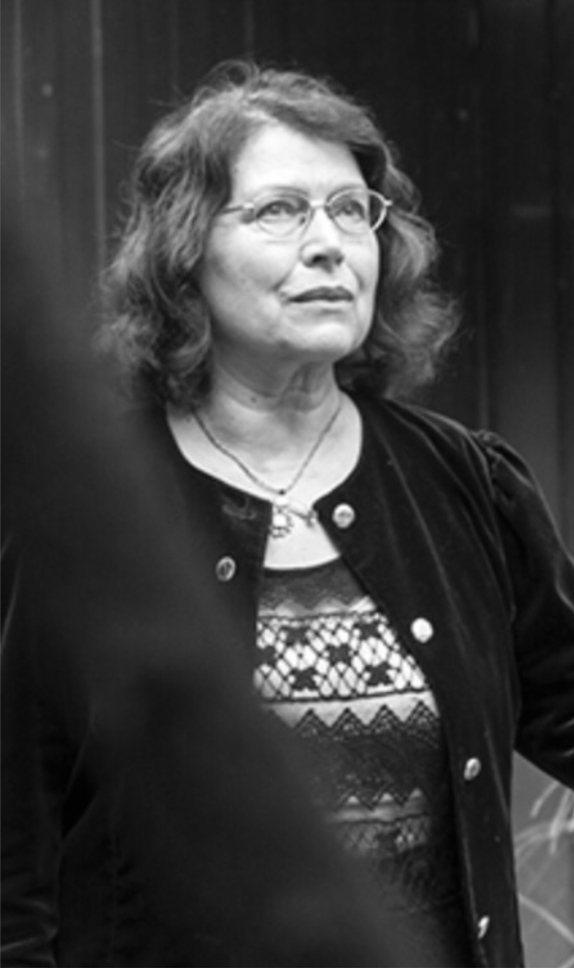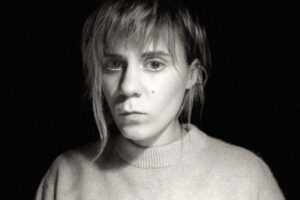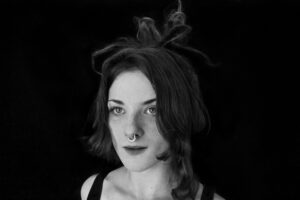Katalin Ladik

– born 1942 in Novi Sad/Újvidék (former Yugoslavia, now Serbia) – a Hungarian poet, actress and performance artist, one of the most prominent representatives of experimental art in former Yugoslavia and Hungary and one of the most influential female artists of the last decades. She graduated from the High School of Economics of Novi Sad in 1961 and continued her studies at the College of Economics in 1960–1962. She studied theatre at the Drama Studio in Novi Sad in 1964–1966. She started her literary career in 1962 while working as a bank assistant. From 1963 to 1977 she worked at Radio Novi Sad and joined the Novi Sad Theatre in 1972. She extended her acting activity to cinema and television as well. She acted as the editor of poetry to Élet és Irodalom (1993–94) and Cigányfúró (1994–99) literary magazines and served as a professor at Hangár musical and theatrical education center (1993–98). She moved to Budapest in 1992 and in the last 20 years she has lived and worked alternately in Novi Sad, Budapest and Hvar Island. Parallel to her written poems she also engages in sound poetry and visual poetry, experimental music and audio plays, actions, performances, mail art and collage. She performs and exhibits her work at prominent international venues and art events including the documenta 14 in 2017. Katalin Ladik received numerous awards, such as the Kassák Lajos Award (1991), the Mediawave Parallel Culture Award (2003), the National Award for Culture of the Republic of Serbia (2009), the Laurel Wreath Award of Hungary (2012) and the prestigious Lennon Ono Grant for Peace in 2016, together with Olafur Eliasson, Anish Kapoor and Ai Weiwei.
First, and above all, I am a poet. I constantly try to expand the boundaries of poetry. Whatever material I use in my work, I always convey a poetic message through it; voice poetry with my voice, concrete poetry with my visual works and collages, and multimedia poetic performances with my body. Artistic creation, creativity and constant change are the key elements of my life. I repeatedly draw inspiration from myself and my environment, my multicultural and multi-ethnic environment, that is, from my roots. I also must get to my own subconscious, to the abysmal lows of my own creation process. Going beyond the time and space also known as descent into the underworld, journey through mazes and labyrinths is a basic theme in the world of artists. As Hungarian poet Attila József puts it [S]he who wants to be a piper must descend to the depths of hell.
All my performances are based on the metaphor of descent into the underworld. However, there are a few connecting and recurring elements in my performances such as music, the white umbrella, the white mask, the moves of a bird’s flight, in any form or in any situation; or the motif of cocooning, of the foetal ball, or of the birth of a creature from the womb. I often refer to the ritual of birth and genesis in my performances. A creature (not necessarily a woman) is giving birth to the son of mankind in agony. The sexes’ struggle with themselves and each other also appears recurrently in my work. My other frequent motif is that of androgyny. The androgyne creature represents the permeability between the sexes, the blurring of gender boundaries and the possible merging of them. There is another frequent motif I am using, the distortion of the face like the motif I am using in my photo performance Poemim (1978)1. I press my face onto a glass plate, it becomes distorted or deformed. These faces reflect our inner selves, the masks which can be found in all of us. I either roll my face in foil or stuff the foil into my mouth. Swallowing is a recurring motif in my works, should it be foil, white silk or stockings what I swallow. Swallowing, ingesting, and ejecting are typical female actions. I do not only use exhalation techniques during the formation of sound in my sound poetry, but I do use inhalation as well, with the filtering effect of the swallowed material. I realized that there was a direct connection between my voice and the reaction of my muscles. My body responds to sound waves, resonates like a cord; the sound shapes my body movement, choreographs the movement. I came up with the poetic phrase “voice-movement”.
The relationship between visuality, the relationship between objects, sounds and movements are the essence of my written and my extended poetry. My art is based on movement, transformation and change. Everything is in constant transformation, in eternal change in nature and in the universe. There are such transitions in the provocative nakedness of Shaman Poem2 – where I am using my naked body as a medium of rebellion and subversion or in the pseudo-nudity in the Blackshave Poem (1978-1979)345. I professed the principle of the artist as an art object in my poetry and performances (Follow me into mythology, Pseudo Presence, Pseudo Sculpture). There is an escape from internal and external chaos into performance, a transition from life to death (Spring Cleaning, 2010-2018)678910. The distancing from my previous life, from my hometown, Novi Sad is symbolized by the action Float Novi Sad Down the Danube (1974)11. The Change Art121314151617181920 action (1975) which took place at the Tribina Mladih in Novi Sad is based on an exchange of objects and ideas between the audience and the artist. I love to sew and embroider; it played a significant role in my paper collages of the seventies. The annexes of typical women’s magazines (Burda) contained tailoring and embroidery patterns, which I used in my collages, and I sang them as a musical score. The beauty of embroidery objects is clearly visible on the surface of the material, but the joy and energy of creation takes place on the reverse, on the underside of the embroidery. I show both sides of my embroidery objects, because showing both sides is the only way the work is complete. The black shadow of my body illuminated by coloured lights on the stage moves in a different dimension: we have little in common with each other, yet we would not exist without each other. It is a way of becoming the opposite of myself.
As an artist, I am very curious and open. In the seventies, I admired the technical instruments in the sound studio of Radio Novi Sad. I especially admired the printed circuits, the secret, mystical information and knowledge kept in them. I made art works from these printed circuits and sang them, made music for them in the seventies. In the same way, the appearance of barcodes and QR codes in our lives filled me with admiration and shivering. My multimedia performance Alice in Codeland (2012-2017) was built on this wonderful and horroristic experience21222324.
The final version of the statement was realized in collaboration with art historian Kata Balázs (2020).
1Image: Katalin Ladik, Poemim, 1978, photo Imre Póth. Courtesy of the artist and acb Gallery, Budapest.2Image: Katalin Ladik, Shaman Poem, 1970, performance photo. Courtesy of the artist and acb Gallery, Budapest.
3Image: Katalin Ladik, Blackshave Poem performance at the Club of Young Artists, Budapest, 1979, photo György Galántai. Courtesy of the artist and acb Gallery, Budapest.
4Image: Katalin Ladik, Blackshave Poem performance at the Club of Young Artists, Budapest, 1979, photo György Galántai. Courtesy of the artist and acb Gallery, Budapest.
5Image: Katalin Ladik, Blackshave Poem performance at the Club of Young Artists, Budapest, 1979, photo György Galántai. Courtesy of the artist and acb Gallery, Budapest.
6Image: Katalin Ladik, Spring Cleaning, 2012, performance at the Mediawave Festival in Komárom, Hungary. Courtesy of the artist.
7Image: Katalin Ladik, Spring Cleaning, 2012, performance at the Mediawave Festival in Komárom, Hungary. Courtesy of the artist.
8Image: Katalin Ladik, Spring Cleaning, 2012, performance at the Mediawave Festival in Komárom, Hungary. Courtesy of the artist.
9Image: Katalin Ladik, Spring Cleaning, 2012, performance at the Mediawave Festival in Komárom, Hungary. Courtesy of the artist.
10Image: Katalin Ladik, Spring Cleaning, 2012, performance at the Mediawave Festival in Komárom, Hungary. Courtesy of the artist.
11Image: Katalin Ladik, Float Novi Sad Down the Danube, 1974, photo László Dormán. Courtesy of the artist and acb Gallery, Budapest.
12Image: Katalin Ladik, Change Art 1975, performance at Tribina Mladih, Novi Sad, Serbia. Courtesy of the artist and acb Gallery, Budapest. Courtesy of the artist and acb Gallery, Budapest.
13Image: Katalin Ladik, Change Art 1975, performance at Tribina Mladih, Novi Sad, Serbia. Courtesy of the artist and acb Gallery, Budapest. Courtesy of the artist and acb Gallery, Budapest.
14Image: Katalin Ladik, Change Art 1975, performance at Tribina Mladih, Novi Sad, Serbia. Courtesy of the artist and acb Gallery, Budapest. Courtesy of the artist and acb Gallery, Budapest.
15Image: Katalin Ladik, Change Art 1975, performance at Tribina Mladih, Novi Sad, Serbia. Courtesy of the artist and acb Gallery, Budapest. Courtesy of the artist and acb Gallery, Budapest.
16Image: Katalin Ladik, Change Art 1975, performance at Tribina Mladih, Novi Sad, Serbia. Courtesy of the artist and acb Gallery, Budapest. Courtesy of the artist and acb Gallery, Budapest.
17Image: Katalin Ladik, Change Art 1975, performance at Tribina Mladih, Novi Sad, Serbia. Courtesy of the artist and acb Gallery, Budapest. Courtesy of the artist and acb Gallery, Budapest.
18Image: Katalin Ladik, Change Art 1975, performance at Tribina Mladih, Novi Sad, Serbia. Courtesy of the artist and acb Gallery, Budapest. Courtesy of the artist and acb Gallery, Budapest.
19Image: Katalin Ladik, Change Art 1975, performance at Tribina Mladih, Novi Sad, Serbia. Courtesy of the artist and acb Gallery, Budapest. Courtesy of the artist and acb Gallery, Budapest.
20Image: Katalin Ladik, Change Art 1975, performance at Tribina Mladih, Novi Sad, Serbia. Courtesy of the artist and acb Gallery, Budapest. Courtesy of the artist and acb Gallery, Budapest.
21Image: Katalin Ladik, Alice in Codeland, 2018, performance at Trafó House of Contemporary Arts, Budapest. Courtesy of the artist.
22Image: Katalin Ladik, Alice in Codeland, 2018, performance at Trafó House of Contemporary Arts, Budapest. Courtesy of the artist.
23Image: Katalin Ladik, Alice in Codeland, 2018, performance at Trafó House of Contemporary Arts, Budapest. Courtesy of the artist.
24Image: Katalin Ladik, Alice in Codeland, 2018, performance at Trafó House of Contemporary Arts, Budapest. Courtesy of the artist.
– szül. 1942, Novi Sad/Újvidék (egykori Jugoszlávia, most Szerbia) – Magyar költő, színésznő és performansz művész. Az egyik legkimagaslóbb képviselője az egykori Jugoszlávia kísérleti művészettel foglalkozó alkotóinak, és az utóbbi évtizedek egyik legbefolyásosabb női alkotója. Közgazdasági középiskolát végzett 1961-ben Újvidéken, majd a Közgazdasági Főiskolán folytatta tanulmányait 1961–62-ben. Az újvidéki drámastúdióban tanult színészetet (1964–1966). Irodalmi pályáját 1962-ben kezdte, miközben banki alkalmazottként dolgozott. 1963 és 1977 között a Radio Novi Sad munkatársa volt, és 1972-ben csatlakozott az újvidéki színház társulatához. Később színésztevékenységét kiterjesztette a filmre és TV-játékokra is. Az Élet és Irodalom (1993–94), illetve a Cigányfúró (1994–99) költészeti rovatának szerkesztőjeként, illetve a HangÁr hang- és színművészeti oktatási központ tanáraként (1993–98) dolgozott. 1992-ben költözött Budapestre és az utóbbi húsz évben felváltva él és dolgozik Újvidéken, a Magyar fővárosban és Hvar szigetén. Írott költeményei mellett hangköltészettel, vizuális költészettel, kísérleti zenével és hangjátékokkal foglakozik, valamint akciókat, performanszokat, mail art és kollázsműveket hoz létre. Performance-ait és műveit kimagasló nemzetközi helyszíneken és művészeti eseményeken mutatja be, mint a documenta 14 keretében is 2017-ben. Ladik Katalin számos elismerésben részesült, munkásságát a Kassák Lajos-díjjal (1991), a Szerb Köztársaság Nemzeti Kulturális Díjával (2009), a Párhuzamos Kultúráért díjjal (2003) ismerték el, valamint Ai Weiwei, Anish Kapoor és Olafur Eliasson mellett a Lennon Ono Békedíjjal (2016) is kitűntették.
Elsősorban és mindenekelőtt költő vagyok. Bármely művészeti műfajban alkotok, mindig a költészet határait igyekszem kibővíteni. Bármilyen anyagot is használok a munkáimban, mindig költői üzenetet közvetítek általa: a hangommal hangköltészetet, vizuális munkáimmal és kollázsaimmal képverseket, a testemmel pedig multimediális, költői performanszot. Az alkotás, kreativitás, az átalakulás és az állandó változás lételemem. Leginkább önmagamból és a környezetemből, a multikulturális és multietnikai környezetemből, azaz a gyökereimből merítek inspirációt. Ezenkívül a saját tudatalattimba és az alkotói folyamat poklába is el kell jutnom. A téridőváltás jól ismert a művészeknél, és az alvilágba szállásnak, labirintusnak, utazásnak szokták nevezni. „Aki dudás akar lenni, pokolra kell annak menni…”, írja József Attila magyar költő.
Minden performanszom az alvilágba süllyedés metaforáján alapul. De az összekötő és ismétlődő elem a performanszokban lehet zene, fehér esernyő, fehér maszk vagy felismerhető mozdulatsor. Ez lehet egy madár repülésének mozdulata, bármilyen formában vagy bármilyen helyzetben; vagy a begubózás, a magzati póz, egy lény méhből valószületése. Előadásaim során gyakran használom a születés, a teremtés rituáléját. Egy lény (nem feltétlenül nő) kínjában szüli meg az emberiség gyermekét. A nemek önmagukkal és a másik nemmel való küzdelme is gyakran megjelenik munkáimban. A másik gyakori motívumom az androgün. A nemek közötti átjárhatóságot és bizonytalanságot, valamint a két nem egybeolvadását, egységét az androgün lény képviseli. Van még egy gyakori motívum, az arc torzulása, mint a Poemim (1978) c. performanszomban1. Átlátszó üvegtáblára nyomom az arcomat, amitől az eltorzul, deformálódik. Ezek az arcok a belső énünket tükrözik, amelyek mindannyiunkban megtalálhatók. Néha nylonfóliába tekerem az arcomat, vagy a számba gyömöszölöm a fóliát. A nyelés visszatérő motívum műveimben, legyen ez fólia, fehér selyem vagy harisnya. A nyelés, a befogadás és a kiürítés, kiadás tipikus női mozdulat. Hangköltészetemben nemcsak a hang kialakulása során használom a kilégzési technikákat, hanem az inhalációt, a belélegzésnél is, a lenyelt anyag szűrőhatásával. Rájöttem, hogy közvetlen kapcsolat van a hangom és az izmaim reakciója között. A testem reagál a hanghullámokra, zsinórként rezonál, a hang átalakítja testmozgásomat. Olyan testi élmény, mint a tüsszögés vagy a köhögés, megmozgatja az izmokat. Ez a mindennapi élmény spontán jött, amit később hangverseimben felhasználtam. Kitaláltam a „hangmozdulat” költői kifejezést. A vizualitás, a tárgyak és a hang, valamint a mozdulat közötti kapcsolat, írott költészetem és a kiterjesztett költészetem egységének lényege. Művészetem a változáson alapszik. A természetben, az univerzumban minden állandó átalakulásban, örök változásban van. Ez az átalakulás a Sámánének2 provokatív meztelenségében – ahol mezítelen testemet a lázadás és a felforgatás közegeként használom – a Blackshave Poem (1978-79)345 álmeztelenségében jelenik meg. A művész, mint műtárgy elvét vallottam költészetemben, performanszaimban. (Gyere velem a mitológiába, Pseudo-presence, Pseudo sculpture). A belső és külső káoszból a performanszba való menekülés, átmenet az életből a halálba (Nagytakarítás 2010-2018)678910. Eltávolodás eddigi életemtől, a szülővárosomtól, Újvidéktől az Újvidék leeresztése a Dunán11 című akció szimbolizálja. A Change Art121314151617181920 akció, mint a tárgyak és ötletek csereakciója a nagyközönség és a művész között, az újvidéki Tribina Mladih-ban történt (1975). Szeretek varrni, hímezni és ez a hetvenes évek papírkollázsaimban nagyon jellemző volt. A női magazínok mellékletében (Burda) szabásminták, hímzés minták voltak, melyeket kollázsaimban felhasználtam, némelyiket pedig zenei partitúraként leénekeltem. A hímzett anyagok szépsége megjelenik a felszínen, de az alkotás öröme, fájdalma és energiája az anyag hátoldalán, a visszáján található. Ilyen munkáimnak mindkét oldalát megmutatom, mert csak így teljes a mű. Az önmaga ellentétévé válás, a pódiumon színes fényekkel megvilágított testem falra vetülő fekete árnyéka más dimenzióban mozog, kevés közünk van egymáshoz, mégsem léteznénk egymás nélkül.
Művészként nagyon kíváncsi és nyitott vagyok. A hetvenes években csodáltam az Újvidéki Rádió (Radio Novi Sad) hangstúdiójában levő műszereket. Különösen a nyomatatott áramköröket csodáltam, a bennük levő számomra titkos, misztikus információkat, tudást. Ezekből a nyomtatott áramkörökből készítettem műtárgyakat és megzenésítettem őket a hetvenes években. Ugyanígy csodálattal és borzongással töltött el a vonalkódok és a QR kódok megjelenése az életünkben. Alice Kódországban című multimediális performanszom erre a csodás és horrorisztikus élményre épült (2012–2017)21222324.
A statement végleges formában Balázs Kata művészettörténésszel együttműködésben született (2020).
1Kép: Ladik Katalin, Poemim, 1978, fotó Póth Imre. A művész és az acb Galéria jóvoltából.2Kép: Ladik Katalin, Sámánének, 1970, performansz fotó. A művész és az acb galéria jóvoltából.
3Kép: Ladik Katalin, Blackshave Poem, 1979, performansz, FMK, Budapest, fotó: Galántai György. A művész és az acb galéria jóvoltából.
4Kép: Ladik Katalin, Blackshave Poem, 1979, performansz, FMK, Budapest, fotó: Galántai György. A művész és az acb galéria jóvoltából.
5Kép: Ladik Katalin, Blackshave Poem, 1979, performansz, FMK, Budapest, fotó Galántai György. A művész és az acb galéria jóvoltából.
6Kép: Ladik Katalin, Nagytakarítás performansz, Mediawave Fesztivál, Monostori Erőd – Filmmúzeum, Komárom, 2012. A művész jóvoltából.
7Kép: Ladik Katalin, Nagytakarítás, 2012, performansz, Mediawave Fesztivál, Monostori Erőd – Filmmúzeum, Komárom. A művész jóvoltából.
8Kép: Ladik Katalin, Nagytakarítás, 2012, performansz, Mediawave Fesztivál, Monostori Erőd – Filmmúzeum, Komárom. A művész jóvoltából.
9Kép: Ladik Katalin, Nagytakarítás, 2012, performansz, Mediawave Fesztivál, Monostori Erőd – Filmmúzeum, Komárom. A művész jóvoltából.
10Kép: Ladik Katalin, Nagytakarítás, 2012, performansz, Mediawave Fesztivál, Monostori Erőd – Filmmúzeum, Komárom. A művész jóvoltából.
11Lép: Ladik Katalin, Újvidék leeresztése a Dunán, 1974, fotó Dormán László. A művész és az acb galéria jóvoltából.
12Kép: Ladik Katalin, Change Art, 1975, performansz, Tribina Mladih, Újvidék. A művész és az acb galéria jóvoltából.
13Kép: Ladik Katalin, Change Art, 1975, performansz, Tribina Mladih, Újvidék. A művész és az acb galéria jóvoltából.
14Kép: Ladik Katalin, Change Art, 1975, performansz, Tribina Mladih, Újvidék. A művész és az acb galéria jóvoltából.
15Kép: Ladik Katalin, Change Art, 1975, performansz, Tribina Mladih, Újvidék. A művész és az acb galéria jóvoltából.
16kép: Ladik Katalin, Change Art, 1975, performansz, Tribina Mladih, Újvidék. A művész és az acb galéria jóvoltából.
17Kép: Ladik Katalin, Change Art, 1975, performansz, Tribina Mladih, Újvidék. A művész és az acb galéria jóvoltából.
18Kép: Ladik Katalin, Change Art, 1975, performansz, Tribina Mladih, Újvidék. A művész és az acb galéria jóvoltából.
19Kép: Ladik Katalin, Change Art, 1975,performansz, Tribina Mladih, Újvidék. A művész és az acb galéria jóvoltából.
20Kép: Ladik Katalin, Change Art, 1975, performansz, Tribina Mladih, Újvidék. A művész és az acb galéria jóvoltából.
21Kép: Ladik Katalin, Alice Kódországban 2018, performansz, Trafó, Budapest. A művész jóvoltából.
22Kép: Ladik Katalin, Alice Kódországban 2018, performansz, Trafó, Budapest. A művész jóvoltából.
23Kép: Ladik Katalin, Alice Kódországban 2018, performansz, Trafó, Budapest. A művész jóvoltából.
24Kép: Ladik Katalin, Alice Kódországban 2018, performansz, Trafó, Budapest. A művész jóvoltából.



